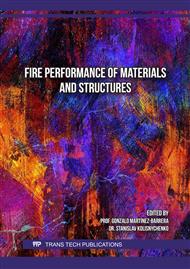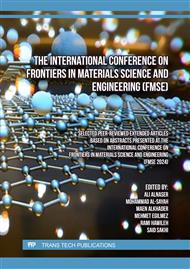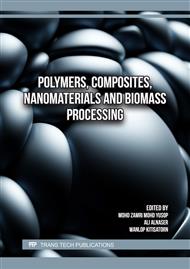[1]
D.N. Brushlinsky, "World Fire Statistics Estadísticas Mundiales de Bomberos Die Feuerwehrstatistik der Welt," p.65, 2022.
Google Scholar
[2]
A. Alhamad, S. Yehia, É. Lublóy, and M. Elchalakani, "Performance of Different Concrete Types Exposed to Elevated Temperatures: A Review," Materials, vol. 15, no. 14, p.5032, Jul. 2022.
DOI: 10.3390/ma15145032
Google Scholar
[3]
F. Dabbaghi, S. Nasrollahpour, M. Dehestani, and H. Yousefpour, "Optimization of Concrete Mixtures Containing Lightweight Expanded Clay Aggregates Based on Mechanical, Economical, Fire-Resistance, and Environmental Considerations," J. Mater. Civ. Eng., vol. 34, no. 2, p.04021445, Feb. 2022.
DOI: 10.1061/(ASCE)MT.1943-5533.0004083
Google Scholar
[4]
H. Huang, Y. Yuan, W. Zhang, B. Liu, A. Viani, and P. Mácová, "Microstructure investigation of the interface between lightweight concrete and normal-weight concrete," Mater. Today Commun., vol. 21, p.100640, Dec. 2019.
DOI: 10.1016/j.mtcomm.2019.100640
Google Scholar
[5]
A. Tanhadoust, T. Yang, F. Dabbaghi, H. K. Chai, M. Mohseni, S. Emadi, and S. Nasrollahpour, "Predicting stress-strain behavior of normal weight and lightweight aggregate concrete exposed to high temperature using LSTM recurrent neural network," Construction and Building Materials, vol. 362, p.129703, Jan. 2023.
DOI: 10.1016/j.conbuildmat.2022.129703
Google Scholar
[6]
M. Shahpari, P. Bamonte, and S. Jalali Mosallam, "An experimental study on mechanical and thermal properties of structural lightweight concrete using carbon nanotubes (CNTS) and LECA aggregates after exposure to elevated temperature," Construction and Building Materials, vol. 346, p.128376, Sep. 2022.
DOI: 10.1016/j.conbuildmat.2022.128376
Google Scholar
[7]
A. Mousa, M. Mahgoub, and M. Hussein, "Lightweight concrete in America: presence and challenges," Sustain. Prod. Consum., vol. 15, p.131–144, Jul. 2018.
DOI: 10.1016/j.spc.2018.06.007
Google Scholar
[8]
R. A. Hawileh, A. Al Rashed, H. H. Mhanna, and J. A. Abdalla, "Properties of concrete with partial replacement of cement with different percentages of micro silica and nano silica," Materials Today: Proceedings, Apr. 2023.
DOI: 10.1016/j.matpr.2023.04.077
Google Scholar
[9]
F. Wegian, "Strength properties of lightweight concrete made with Leca grading," Australian Journal of Civil Engineering, vol. 10, no. 1, 2012.
DOI: 10.7158/c10-668.2012.10.1
Google Scholar
[10]
R. A. Hawileh, J. A. Abdalla, W. Nawaz, A. Sharif Zadeh, A. Mirghani, A. Al Nassara, A. Khartabil, and M. Shantia, "Effects of replacing cement with GGBS and fly ash on the flexural and shear performance of reinforced concrete beams," Practice Periodical on Structural Design and Construction, vol. 29, no. 2, May 2024.
DOI: 10.1061/ppscfx.sceng-1339
Google Scholar
[11]
V. Kodur, "Properties of Concrete at Elevated Temperatures," Int. Sch. Res. Not., vol. 2014, p. e468510, Mar. 2014.
DOI: 10.1155/2014/468510
Google Scholar
[12]
Z. Guo, "Chapter 19 - Fire Resistance," in Principles of Reinforced Concrete, Z. Guo, Ed., Oxford: Butterworth-Heinemann, 2014, p.475–520.
DOI: 10.1016/B978-0-12-800859-1.00019-0
Google Scholar
[13]
H. Hostetter, M. Z. Naser, R. A. Hawileh, G. Karaki, and H. Zhou, "Enhancing fire resistance of reinforced concrete beams through sacrificial reinforcement," Architecture, Structures and Construction, vol. 2, no. 2, p.311–322, Jul. 2022.
DOI: 10.1007/s44150-022-00061-w
Google Scholar
[14]
R. A. Hawileh, S. Quadri, J. A. Abdalla, M. Assad, B. Thomas, D. Craig, and M. Z. Naser, "Residual mechanical properties of recycled aggregate concrete at elevated temperatures," Fire and Materials, vol. 48, no. 1, p.138–151, Jun. 2023.
DOI: 10.1002/fam.3168
Google Scholar
[15]
M. Zhang, L. Zhu, S. Gao, T. Liu, and H. Yuan, "Mechanical properties, microstructure, and environmental assessment of recycled concrete from aggregate after fire," Construction and Building Materials, vol. 425, p.136074, Apr. 2024.
DOI: 10.1016/j.conbuildmat.2024.136074
Google Scholar
[16]
G. Kim, G. Choe, M. Yoon, and T. Lee, "Mechanical properties of light weight concrete at elevated temperature," International Journal of Precision Engineering and Manufacturing, vol. 16, no. 8, p.1867–1874, Jul. 2015.
DOI: 10.1007/s12541-015-0243-6
Google Scholar
[17]
R. El-Hacha, M. F. Green, and G. R. Wight, "Effect of Severe Environmental Exposures on CFRP Wrapped Concrete Columns," J. Compos. Constr., vol. 14, no. 1, p.83–93, Feb. 2010.
DOI: 10.1061/(ASCE)CC.1943-5614.0000074
Google Scholar
[18]
J. Lee, K. Choi, and K. Hong, "The effect of high temperature on color and residual strength of concrete," in Fracture Mechanics of Concrete and Concrete Struct., Jeju, North Korea, May 23-28, 2010.
Google Scholar
[19]
I. Hager, "Colour Change in Heated Concrete," Fire Technol., vol. 50, no. 4, p.945–958, Jul. 2014.
DOI: 10.1007/s10694-012-0320-7
Google Scholar
[20]
E. Sancak, Y. Dursun Sari, and O. Simsek, "Effects of elevated temperature on compressive strength and weight loss of the light-weight concrete with silica fume and superplasticizer," Cem. Concr. Compos., vol. 30, no. 8, p.715–721, Sep. 2008.
DOI: 10.1016/j.cemconcomp.2008.01.004
Google Scholar
[21]
H. Tanyildizi and A. Coskun, "The effect of high temperature on compressive strength and splitting tensile strength of structural lightweight concrete containing fly ash," Constr. Build. Mater., vol. 22, no. 11, p.2269–2275, Nov. 2008.
DOI: 10.1016/j.conbuildmat.2007.07.033
Google Scholar
[22]
Standard Practice for Making and Curing Concrete Test Specimens in the Field, ASTM C31/31M. 2019.
Google Scholar
[23]
Standard Test Method for Compressive Strength of Cylindrical Concrete Specimens, C39/C39M. 2012.
Google Scholar
[24]
Standard Practice for Capping Cylindrical Concrete Specimens, C617/C617M. 2015.
Google Scholar




